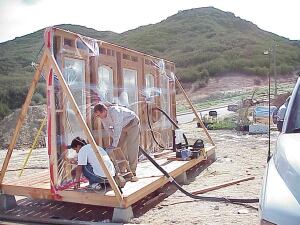Three-coat stucco is the most common exterior cladding here in Southern California; properly installed, it’s tough, durable, and attractive. But it’s not waterproof. No matter how skilled the plasterer is, rain will get behind stucco.
My inspection business investigates moisture problems for several large builders in the region. Not a week goes by that we aren’t water-testing a stucco installation, typically looking for a suspected window leak. What we’ve learned is that the windows themselves are actually fairly weatherproof; more often than not, it’s the building paper and the flashing around the window that leak.
Get the Drainage Plane Right
Once you accept that the stucco itself lets water through, it’s easy to understand why the building envelope must be made watertight before the stucco is applied. In my experience, it doesn’t really matter whether the walls are covered with housewrap or Grade D 60-minute paper, as long as you use two layers. The first layer — the one against the sheathing — acts as the drainage plane, while the top layer is sacrificial and protects the bottom layer from construction damage. Even when the stucco actually sticks to the top layer, water can still drain out of the assembly.
I always recommend 60-minute Grade D building paper as the first layer; when it gets wet, it plumps up, which helps to seal around penetrations from lath fasteners. I prefer Fortifiber’s Super Jumbo Tex (800/773-4777, fortifiber.com) because of its consistently reliable quality. Other brands seem to work well too, as long as the paper is actually 60-minute paper. Codes require only that it be Grade D paper, so unless you actually specify 60-minute, you may end up with less-expensive 30-minute or even 10-minute paper.

Regardless of which water-resistive barrier you choose, it’s only as good as the installation. I still see builders cover the rough window opening with housewrap, cut an X, then pull the wrap into the opening on all four sides before setting the window. I guarantee this installation will leak. The flap of housewrap above the window must be held up temporarily until the window is installed and flashed, then pulled down over the window flashing and taped into place (see illustration). I also commonly find reverse laps in the building paper, especially under windows and under shutter blocks, which are the pieces of wood nailed up for securing decorative shutters.
Be sure to follow minimum overlap requirements for the building paper, which by code are 6 inches vertically and 2 inches horizontally. I’d rather see at least 8 inches vertically and 4 inches horizontally; it’s cheap insurance.
Flashing Tips
Another mistake we often find around windows is that self-adhering flashing tape has been applied over the bottom nailing fin. Water that leaks in around the window frame gets trapped behind the flashing and causes the adhesive to fail. Instead of sealing water out, the failed membrane actually channels water into the wall cavity.
We’ve tested various flashing products to see how they behave under field conditions, and have had good results with Fortifiber’s Moistop neXT and Fortiflash, DuPont’s FlexWrap and StraightFlash, Rainbuster 415 and 420 (800/473-1617, topindustrial.com), and OSI Winteq TeQ:Flash cold-weather butyl flashing paper (800/624-7767, osipro.com). Some of these products require primers under certain conditions, so be sure to follow the directions. We’ve found that even when not required, a primer can often improve adhesion. I also recommend manufactured flashing corners, like the Rainbuster 425.
Electrical and plumbing penetrations. Many builders will just plug small openings with sealant, which often fails over time. For more reliable results, we recommend QuickFlash flashing panels (800/963-6886, quickflashproducts.com), which are specifically sized for different types of electrical boxes, light fixtures, and plumbing/hvac pipes. These products are easy to install and not terribly expensive, but need to be ordered in advance.
Lath Lessons
Some contractors fasten metal lath to the wall with pneumatic staples, but we’ve found that this can cause problems. For one thing, a staple has two prongs, so it creates twice as many penetrations as a nail. Furring nails are preferable; they have a small cork washer that helps space the lath away from the wall and also seals around the nail.. Take the time to ensure that every furring nail is perpendicular to the wall, and that the cork is compressed against the sheathing.
When nailing up lath wire, a good rule of thumb is to keep furring nails three fingers away from windows and doors. This ensures that you don’t damage the nailing fins.
Corners. At inside corners, the stucco crew often use their hatchets to bend the lath. As a result, we often find tears in the building paper. Preformed inside corners like Cornerite are a good solution to this problem.
Screeds
To allow water to escape, the base of the wall should always terminate with a metal screed. There are two basic types: the kind with weep holes and the kind without. I prefer screeds with holes, because for many years I’ve seen them work effectively..
In high-wind areas — second-floor decks overlooking the ocean, for example — it’s a good idea to flash the screed’s nail fin with a 9- to 12-inch-wide strip of self-adhering flashing paper, such as RainBuster 415, Fortiflash Butyl, or DuPont Straight Flash. This will provide extra protection against water blown up into the wall in a driving rain.
Be careful not to paint over the seam where the metal and the stucco meet, especially with an elastomeric paint. This will simply block the escape route for any water that gets behind the stucco. Unfortunately, I also commonly see metal screeds that have been buried behind patio paving or landscaping. At minimum, code requires 2 inches of clearance between the screed and a walking surface, and 4 inches of clearance above the ground.
Gene Summy owns TLS Laboratories in Laguna Niguel, Calif.











